For decades, minoxidil has been the go-to treatment for hair loss. Many men and women have seen results — but also faced limits: slow progress, scalp irritation, and the need for high concentrations. Now, science is giving this classic treatment a powerful upgrade. Researchers are developing “Minoxidil 2.0”, a new generation that uses nanocarriers — ultra-tiny delivery systems that help minoxidil reach the root of your follicles more effectively.
Early studies are already showing promise: nano-based formulations let more of the active ingredient penetrate into the hair follicle, reduce side effects, and may even work at lower doses with better results (National Library of Medicine). This isn’t a far-off dream — it’s a development that’s already in late-stage research and moving closer to reality.
But to understand why nano-formulations are such a breakthrough, we first need to look at the limits of traditional minoxidil.
💊 The Limitations of Traditional Minoxidil
Minoxidil has been a trusted name in hair loss treatments for more than 30 years. For many, it has slowed shedding and encouraged new growth. But here’s the truth: classic minoxidil isn’t perfect.

The main problem is absorption. Human skin, especially the scalp, is designed to protect us and block substances from entering too deeply. Traditional minoxidil solutions often struggle to reach the hair follicle — the real “engine room” of growth — which means only a small portion of the active ingredient actually gets to where it’s needed most. Research shows that less than 2% of a typical topical minoxidil solution penetrates through the skin barrier, limiting its effectiveness (PubMed).
Another challenge is irritation. To help minoxidil pass through the skin, many products include alcohol and propylene glycol. These solvents improve penetration but often cause dryness, itching, or redness — issues reported by a significant number of users (PubMed).
Finally, minoxidil itself is a prodrug, meaning it must be converted into its active form (minoxidil sulfate) by enzymes in the scalp. Unfortunately, not everyone’s scalp produces enough of these enzymes, which partly explains why some people respond well to minoxidil, while others see only modest changes (Wikipedia).
👉 Bottom line: traditional minoxidil works, but its limitations keep many people from seeing the full potential results. That’s why researchers have been looking for a smarter way to deliver it — and this is where nanocarriers come into play.
⚗️ Nanocarriers: A Smarter Delivery System
To deliver the active ingredients directly to the targeted site — namely the follicle, or the very root of the hair — scientists rely on the already mentioned nanocarriers 🚀, tiny high-tech vehicles designed for precise delivery.
How do they work?
- Nanostructured Lipid Carriers (NLCs) can enhance the journey of minoxidil, guiding it through the skin barrier and concentrating it inside the hair follicle, right where new growth begins. ✨
- Polymeric nanocapsules (PNPs) act like protective bubbles, releasing the active ingredient gradually, which not only improves penetration but also reduces the risk of scalp irritation. 🌿
- Liposomes and nanoemulsions make minoxidil more soluble, which means it spreads evenly and stays active longer on the scalp.

Why is this better than traditional formulas?
- Targeted delivery: More minoxidil reaches the follicle — less is wasted on the skin’s surface.
- Gentler on the scalp: By reducing harsh solvents, nano-formulations minimize itching and dryness. 💧
- Potential for lower doses: With improved absorption, effective results may come with smaller amounts of the drug.
💡 In short: Nanocarriers are like precision tools that can help minoxidil work smarter, not harder — unlocking stronger and more comfortable hair growth outcomes. 🌱
🚀 Clinical Evidence: Nano-Minoxidil in Action
It’s one thing to have a promising idea, but what do the studies actually show? 📊 Over the past few years, scientists have tested nanocarrier-based minoxidil in both labs and real people — and the results are encouraging.
🔬 Research Highlights
- Enhanced Follicle Targeting: A 2022 study reported that minoxidil delivered via nanostructured lipid carriers (NLCs) reached hair follicles up to ten times more effectively than standard liquid solutions, suggesting a much higher local availability of the drug (MDPI).
- Reduced Irritation: Traditional minoxidil often relies on alcohol-based solvents, which can cause dryness or redness. Nanocapsule systems helped minimize these side effects while maintaining — or even improving — the growth response. 🌿
- Lower Doses, Stronger Impact: Researchers found that using smaller concentrations of minoxidil inside nanoformulations still achieved superior hair growth outcomes compared to higher doses of regular solutions (MDPI).
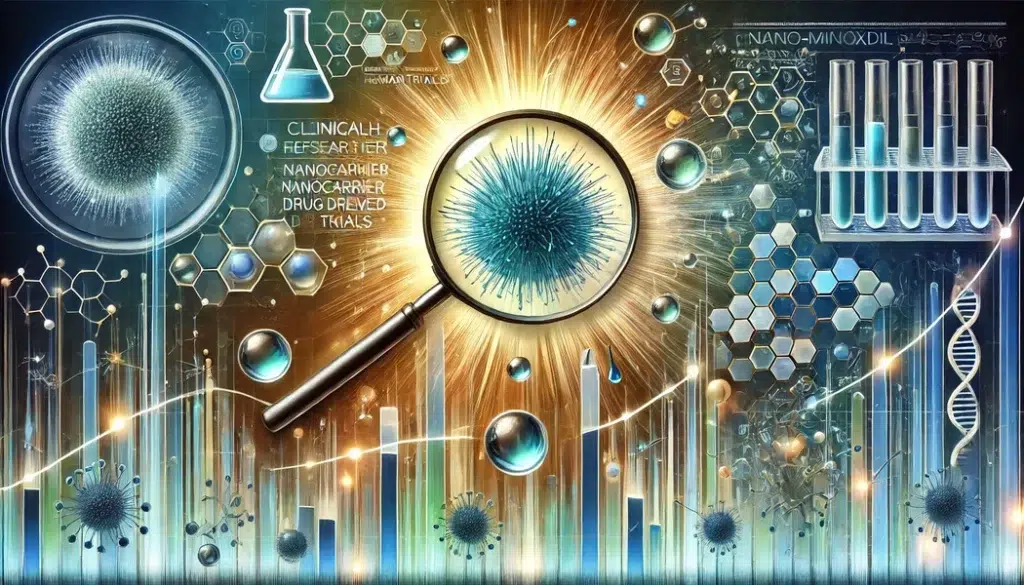
What This Means for You
The science is moving from theory to reality. With nanocarrier technology, minoxidil may soon work faster, deeper, and more comfortably than ever before. That’s not just a lab success — it’s a glimpse into a future where hair regrowth treatments are more effective and easier on your scalp. ✨
🌱 Beyond Strength: The Promise of Lower Doses & Fewer Side Effects
One of the most exciting insights from nano-formulations is that stronger isn’t always better — maximal effectiveness can be achieved even as concentrations go down.
This is exactly where nanocarrier systems change the game. By encapsulating minoxidil in tiny lipid-based or polymer-based particles, researchers have shown that the drug can be delivered more efficiently into the follicle, rather than sitting on the scalp surface. The result?
- Lower concentrations are needed to achieve the same — or even better — follicular penetration.
- Reduced skin irritation, since less alcohol and fewer additives are required.
- More consistent absorption, which means fewer missed doses and steadier results over time.
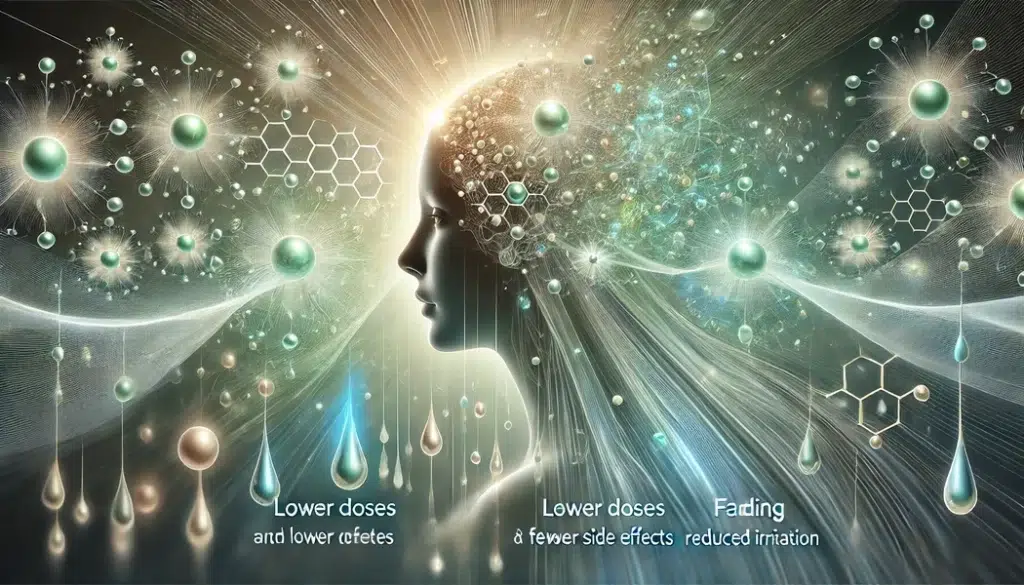
In practice, this could make minoxidil not just more powerful, but also more tolerable for people who previously struggled with side effects. That opens the door for a much wider audience to actually benefit from this proven hair growth molecule without the drawbacks that kept many away.
🧪 Smarter Formulations: Liposomes, Niosomes & Solid Lipid Nanoparticles
If standard minoxidil is like pouring water on a waxed jacket, nanocarriers are the technology that lets those droplets actually sink in. Researchers have been experimenting with different types of nanoscale delivery systems to ensure minoxidil reaches the follicle bulb — the “engine room” where hair growth starts.
🔹 Liposomes – the soft protectors
Liposomes are tiny, bubble-like spheres made from the same materials as cell membranes. By wrapping minoxidil inside these lipid bubbles, scientists can improve its solubility and help it slip through the scalp’s outer barrier. Studies show liposomal minoxidil can stay longer in the skin and release the drug more steadily, rather than evaporating too quickly.
🔹 Niosomes – stable and skin-friendly
Niosomes are cousins of liposomes, but instead of phospholipids they use non-ionic surfactants. This makes them more stable, less costly, and gentler on the skin. Early clinical data suggest niosomal minoxidil can improve hair density while lowering the chances of itching or flaking — a common complaint with alcohol-based solutions.
🔹 Solid Lipid Nanoparticles (SLNs) – precise delivery
SLNs are solid, fat-based carriers at the nanoscale. They can encapsulate minoxidil and release it gradually, like a timed delivery service ⏱️. This not only enhances drug penetration to the hair follicle but also minimizes systemic absorption, potentially reducing side effects such as unwanted hair growth on other areas of the body (PubMed).

Together, these innovations signal a shift from the “more is better” approach to a more intelligent, efficient, and comfortable way of using minoxidil. Instead of overloading the scalp with high concentrations, nanocarriers allow each molecule to do its job exactly where it’s needed.
⚙️ From Lab to Real Life: What Clinical Trials Reveal
Early lab experiments are exciting, but the real question is: does nano-enhanced minoxidil actually work on people struggling with hair loss? Recent clinical trials have started to provide answers, showing that this next generation of delivery systems can deliver real, visible benefits outside the laboratory.
📑 Key Findings from Studies
- Stronger follicle targeting: Research on nanostructured lipid carriers (NLCs) loaded with minoxidil reported up to tenfold higher follicular uptake compared to standard 5% topical solutions (MDPI, 2023).
- Reduced irritation: Research shows that minoxidil encapsulated in a liquid crystal nanocarrier can selectively target pilosebaceous follicles, significantly enhancing its biological efficacy while reducing side effects compared to conventional hydroalcoholic formulations (PubMed Central).
- Lower doses, greater impact: Because nanocarriers release minoxidil gradually and direct it into the follicle, effective regrowth can often be achieved at lower concentrations, reducing systemic side effects and improving comfort.
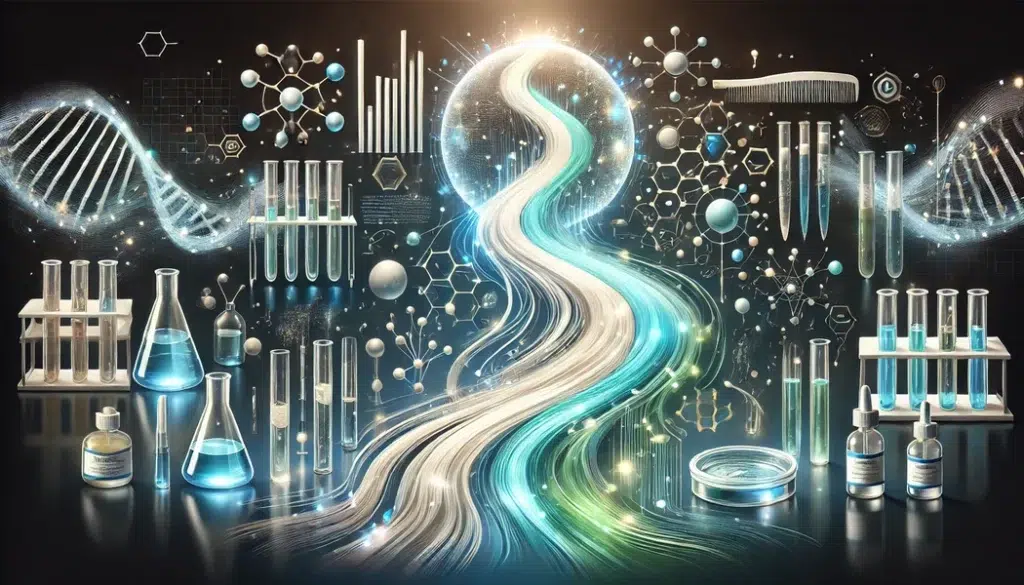
🔗 Connecting Science With Your Journey
In the first part of our nanotechnology series, we explored how nano-delivery systems are reshaping the future of hair health. Now, clinical evidence confirms that these advances aren’t just theoretical — they’re paving the way for smarter, more tolerable minoxidil therapies.
👉 While we wait for this new generation of treatments to hit the market, it’s important to support your scalp and hair with proven, natural solutions. That’s why we’ve researched and selected the best hair growth conditioner and a high-quality hair supplement that can help keep your hair strong, healthy, and ready to respond even better once Nano-Minoxidil becomes available. 🌿
🔮 The Future of Minoxidil Therapy
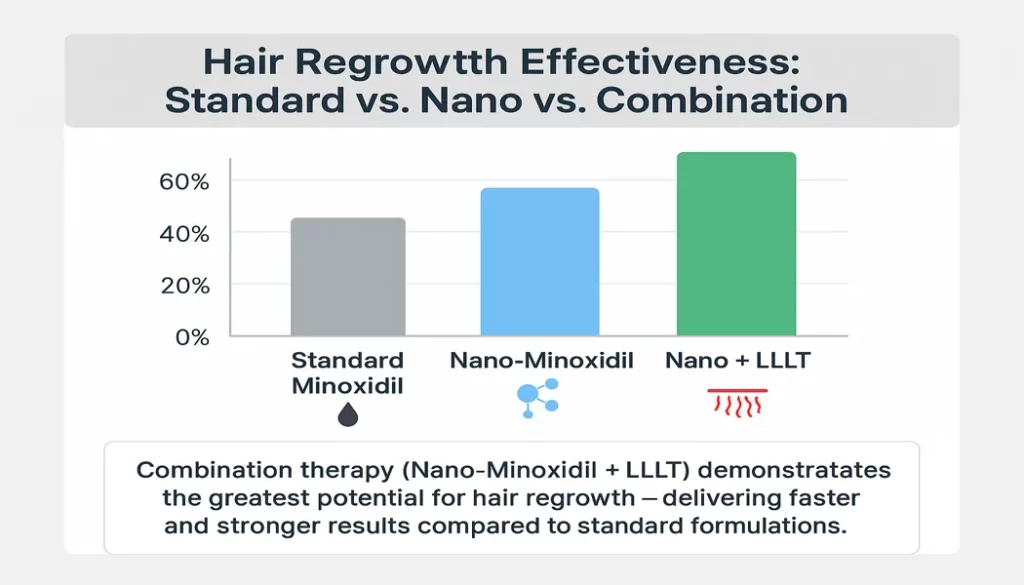
The science around minoxidil is evolving faster than ever. Researchers are no longer asking “does it work?” — they’re asking “how can we make it work even better, with fewer downsides?” ⚡
🔗 Smarter Combinations Ahead
One of the most promising directions is combination therapy. Early studies suggest that pairing nano-minoxidil with low-level laser therapy (LLLT) — a non-invasive light treatment — could create a synergistic effect. Lasers help stimulate blood flow and cellular energy, while nanocarriers deliver minoxidil right into the follicle. Together, this double strategy may accelerate growth far beyond what either method can achieve alone (NIH).
🧘 Stress, Lifestyle & Supplements
Science also shows that chronic stress can trigger or worsen hair loss by disrupting the natural hair cycle (Cleveland Clinic). That’s why future approaches to hair restoration won’t just stop at topical solutions — they’ll also focus on calming the body and mind. Adaptogenic anti-stress supplements rich in ingredients like ashwagandha or magnesium may help balance cortisol levels, creating a healthier internal environment for hair follicles. 🌿
✨ What This Means for You
The future of hair regrowth is not about choosing one miracle product. It’s about integrating advanced science with holistic care.
Simple lifestyle choices can already make a big difference.
A nutrient-rich diet gives your follicles the raw materials they need for growth.
Even moderate physical activity boosts circulation and supports a healthier scalp.
Avoiding excessive alcohol intake helps maintain your hormonal balance.
If you smoke, know that quitting can significantly improve scalp oxygenation.
Reducing your intake of sugary fizzy drinks may also protect your hair over time.
And limiting your exposure to polluted air can shield your follicles from oxidative damage. 🌿
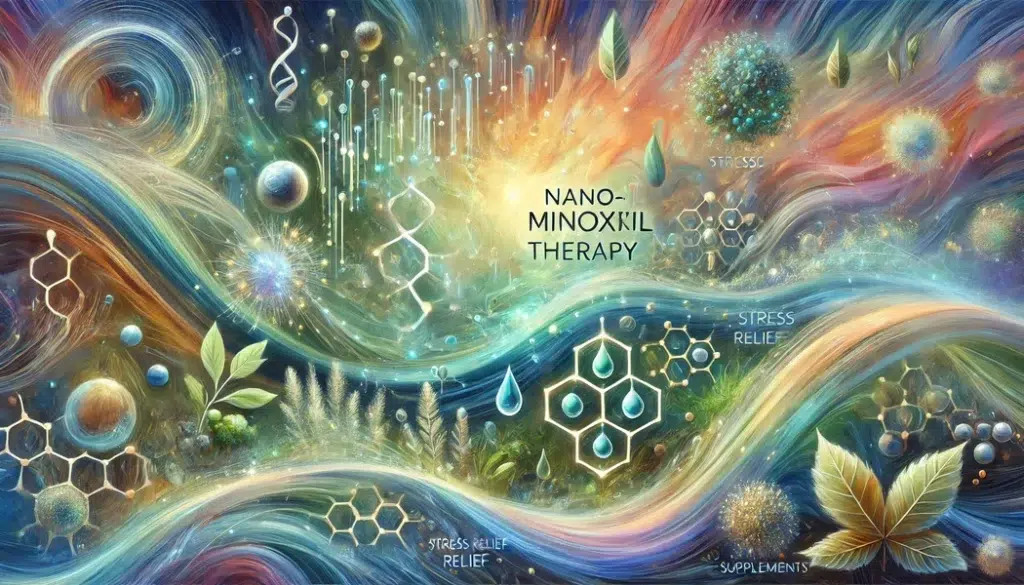
Until nano-minoxidil becomes widely available, you can already support your scalp by combining proven treatments — including a carefully researched hair growth conditioner and a science-backed supplement we’ve selected for you for its exceptional quality — to help protect your hair and prepare for the exciting innovations ahead.
✅ Key Takeaways
- Nano-minoxidil is no longer science fiction — first studies already show it delivers minoxidil deeper into the hair follicle and up to 10× more effectively than standard solutions. 🚀
- Thanks to liposomes, niosomes, and solid lipid nanoparticles, minoxidil can be released gradually and directly where it matters most.
- This precision means lower doses, fewer side effects, and a smoother experience for people who couldn’t tolerate traditional formulas.
- Combined with low-level laser therapy and stress-balancing supplements, the results look even more promising. ✨
- While we wait for official product launches, you can already support your scalp with the best natural hair growth shampoo and targeted supplements to keep your hair strong and ready.
Want healthier, stronger hair? Discover 8 science-backed habits that protect your scalp and boost natural growth. Get your free PDF guide today!
I’m Ruda — a passionate explorer of hair health, natural solutions, and the power of belief. 🌱 If you want to know more about my story and why I started this journey, visit my About Me page.
💡 The exciting part? We’re entering the final stretch — Minoxidil 2.0 is on the horizon. Stay connected with us here: we’ll be the first to share the latest breakthroughs and guide you step by step. Your journey to stronger, healthier hair is only just beginning. 🌱💪
Some links in this article are affiliate links. If you choose to make a purchase through them, I may earn a small commission at no extra cost to you — helping me keep HairGrowGenius running. Thank you for your support!

❓ FAQ
⏳ How soon could Nano-Minoxidil become available?
Current research is already in late-stage testing, and experts believe nano-based minoxidil could become available in the near future. While exact dates depend on regulatory approvals, the progress so far shows it’s not a distant dream but an upcoming reality.
🔄 Will Nano-Minoxidil completely replace regular minoxidil?
Not immediately. Traditional minoxidil will likely remain on the market, but nano-formulations are designed to improve absorption, comfort, and results. Over time, many users may prefer them, especially if they deliver stronger regrowth with fewer side effects.
🌱 What can I do right now to prepare for future treatments?
Focus on protecting your existing hair and scalp health. Simple steps like using a natural DHT-blocking shampoo and taking science-backed supplements can help maintain a strong foundation — so when Nano-Minoxidil arrives, your follicles are ready to respond at their best.
Sources
- Cleveland Clinic (2022) – Telogen Effluvium: Symptoms, Causes, Treatment & Regrowth
- MDPI (2023) – Improved Follicular Delivery of Minoxidil by Nanostructured Lipid Carriers (NLCs)
- National Library of Medicine (2023) – Advances in Topical Minoxidil Formulations: Novel Strategies for Effective Follicular Delivery
- PubMed (2020) – Applications and efficacy of minoxidil in dermatology
- PubMed (2016) – Sulphotransferase activity in human scalp hair follicles: Implications for topical minoxidil response
- PubMed (2024) – Solid Lipid Nanoparticles as Drug Delivery Systems for Hair Follicle Targeting
- Wikipedia – SULT1A1
- Brieflands (2021) – Evaluation of Topical Minoxidil Nanosuspension in Androgenetic Alopecia
- PubMed (2025) – Comparative efficacy and safety of low-level laser therapy (LLLT) combined with topical minoxidil vs. minoxidil alone in androgenetic alopecia

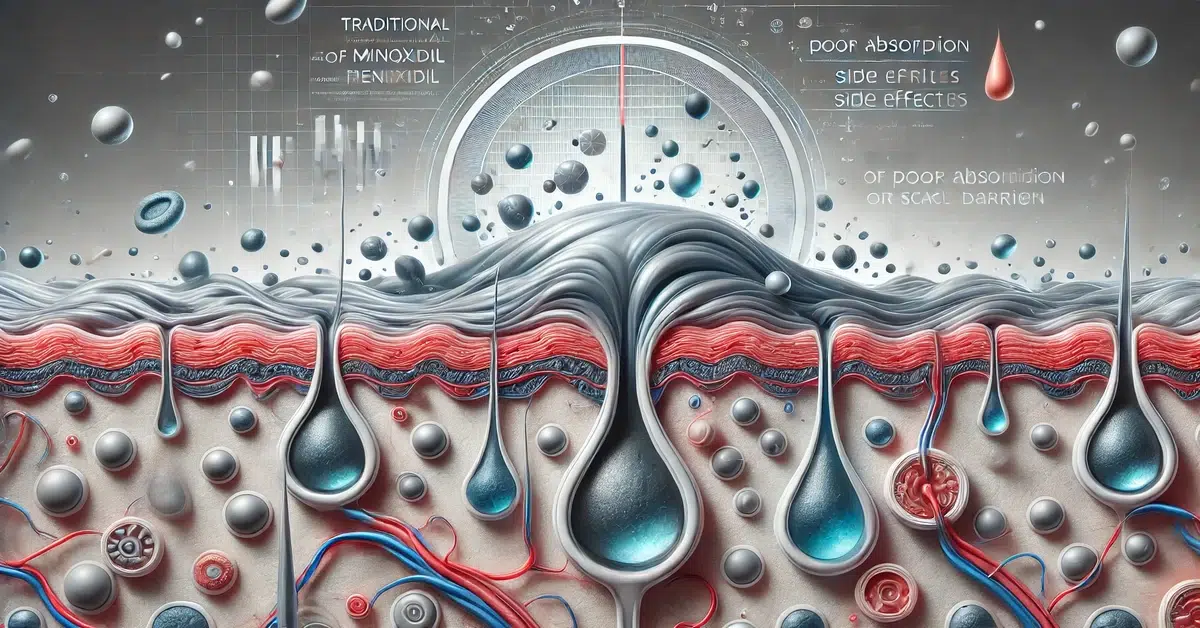
Leave a Reply